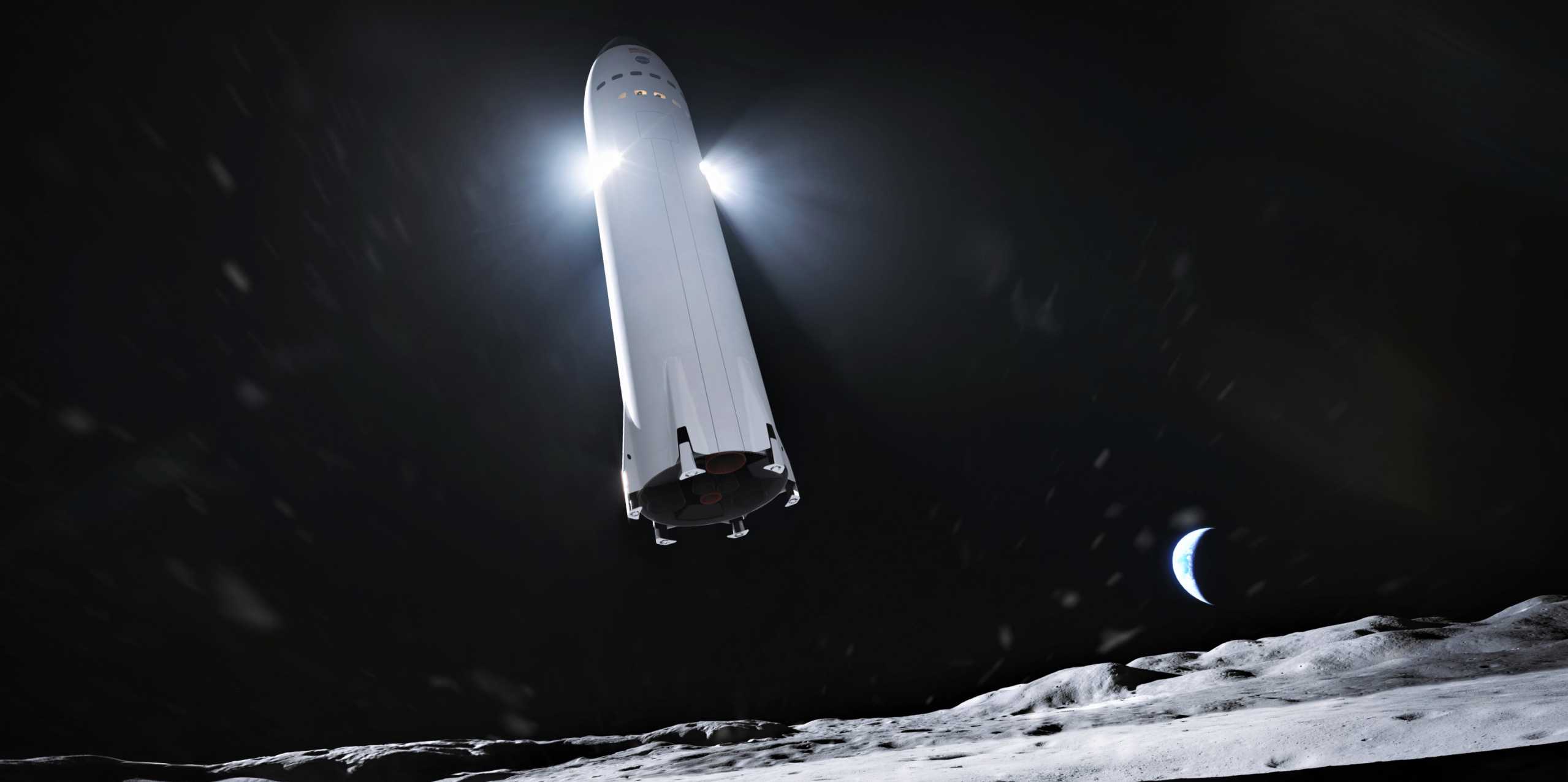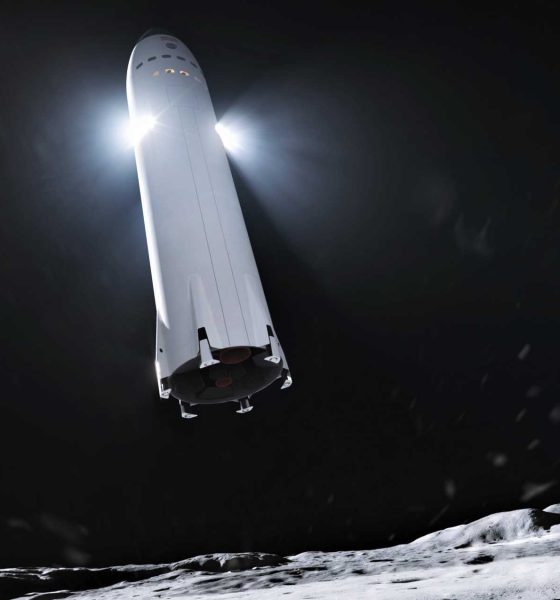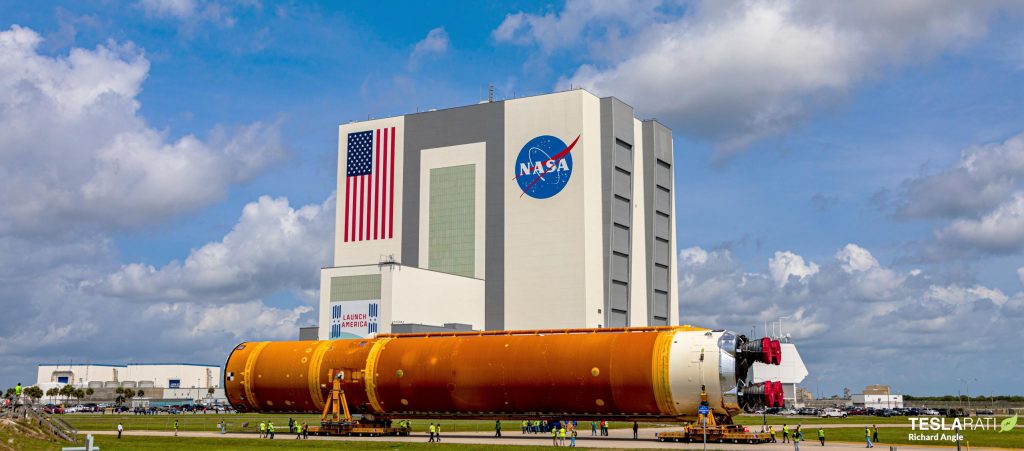

News
SpaceX, NASA celebrate Blue Origin’s lunar lander lawsuit loss and get back to work
In a November 9th press conference, NASA leaders have begun to publicly celebrate the end of seven months of Blue Origin litigation and disruption to its Human Landing System (HLS). A federal court’s dismissal of that lawsuit means that the space agency can finally get back to work with SpaceX on its Starship Moon lander.
Following the failure of that lawsuit, NASA administrator Bill Nelson says that it will take the space agency some time to fully determine what and how much damage Blue Origin has caused. In the briefing, Nelson and associate administrators Kathy Lueders and Jim Free confirmed that Dynetics’ protest and Blue Origin’s protest and lawsuit have delayed SpaceX’s first crewed Starship Moon landing to no earlier than (NET) 2025.
Painfully, though, the briefing primarily focused on NASA’s Space Launch System (SLS) rocket and Orion spacecraft and the latest news about the system and the space agency’s attitude towards it are not encouraging.
Namely, exemplifying just how broken and deceptive NASA’s cost “transparency” is when it comes to SLS and Orion, the space agency used the briefing to announce its first updated Orion cost projections in more than half a decade. All the way back in September 2015, NASA announced major Orion delays and revealed that it had already spent $4.7B on the spacecraft and was committing another $6.7B through its first crewed launch – then scheduled no earlier than 2023.
That’s likely where NASA is getting its magically diminished Orion cost estimate. In reality, including Bush-era Constellation Program development that began in 2006, Orion will have cost NASA and the US taxpayer almost $22 billion by the end of 2021 and before a single full-up launch. Effectively doing the bare minimum to acknowledge a sanitized version of reality, NASA now says that Orion will cost at least $9.3 billion to its first crewed launch, which has been delayed to NET May 2024. It’s entirely unclear how NASA is calculating that deflated figure but in the six years since the space agency’s 2015 announcement that it would spend another $6.7B before Orion’s first crewed launch, it’s actually spent at least $8.4B and will have blown past the latest $9.3B target by mid-2022. Barring drastic funding cuts, Orion development will actually cost the US about $12.6B from 2016 to Artemis II and ~$25.8B since 2006 (not including inflation).
In an even starker demonstration of cognitive dissonance, when a New York Times reporter asked a hard question about the possibility of sidestepping Orion and SLS to get astronauts onto SpaceX’s Starship lunar lander, Administrator Nelson – having just repeatedly discussed Starship – fell back on an old boilerplate statement that “there’s only one rocket capable of doing this” – “this” being launching humans to the Moon and returning them to Earth and that “one rocket” being SLS. Association admin Jim Free also exhibited similar confusion, stating that “the architecture…just wouldn’t work.”
In reality, as currently contracted with NASA, SpaceX’s Starship Moon lander is a highly capable crewed spacecraft that will be refueled in Earth orbit before propelling itself to lunar orbit, where an SLS-launched Orion spacecraft would join it and transfer over three astronauts. Starship would then use its own propulsion to change orbits, land on the Moon, and eventually boost back into lunar orbit to transfer that crew back to Orion for the return to Earth. Nothing short of sheer ignorance – willful or not – could prevent competent spaceflight engineers or managers from understanding the possibilities such an architecture raises.
If NASA is already committed to human-rating Starship’s propulsion systems, which it is, it doesn’t take a grand leap of imagination to consider the possibility of adding a few more burns to Starship’s extremely complex concept of operations. If, for example, Starship has enough performance to return to Earth orbit from the lunar surface, it’s not hard to imagine NASA’s Artemis astronauts boarding Starship in Earth orbit after a far cheaper commercial launch and then returning to Earth orbit to debark Starship and return to that crew-rated reentry vehicle. As it turns out, NASA already has a highly successful crew-rated commercial rocket and spacecraft that’s already operational and likely more than 10 times cheaper than SLS/Orion.

While there are obvious challenges and uncertainties with such an option, the point is more that failing to even acknowledge the possibility of alternatives is a brutal appraisal of several of NASA’s most senior leaders and confirms that the politics of a jobs program like SLS/Orion is actively disrupting their ability to engage with reality and properly manage complex, risky programs.
Ultimately, it’s great news that SpaceX and NASA can finally get back to work on their Starship Moon lander plans. However, it’s also clearer than ever that SLS and Orion will remain a noose precariously balanced around the agency’s neck, forever threatening the Artemis Program and stifling NASA’s ability to seriously plan for – let alone publicly entertain or even acknowledge – contingencies or fresh ideas.

News
Elon Musk’s Grokipedia surges to 5.6M articles, almost 79% of English Wikipedia
The explosive growth marks a major milestone for the AI-powered online encyclopedia, which was launched by Elon Musk’s xAI just months ago.

Elon Musk’s Grokipedia has grown to an impressive 5,615,201 articles as of today, closing in on 79% of the English Wikipedia’s current total of 7,119,376 articles.
The explosive growth marks a major milestone for the AI-powered online encyclopedia, which was launched by Elon Musk’s xAI just months ago. Needless to say, it would only be a matter of time before Grokipedia exceeds English Wikipedia in sheer volume.
Grokipedia’s rapid growth
xAI’s vision for Grokipedia emphasizes neutrality, while Grok’s reasoning capabilities allow for fast drafting and fact-checking. When Elon Musk announced the initiative in late September 2025, he noted that Grokipedia would be an improvement to Wikipedia because it would be designed to avoid bias.
At the time, Musk noted that Grokipedia “is a necessary step towards the xAI goal of understanding the Universe.”
Grokipedia was launched in late October, and while xAI was careful to list it only as Version 0.1 at the time, the online encyclopedia immediately earned praise. Wikipedia co-founder Larry Sanger highlighted the project’s innovative approach, noting how it leverages AI to fill knowledge gaps and enable rapid updates. Netizens also observed how Grokipedia tends to present articles in a more objective manner compared to Wikipedia, which is edited by humans.
Elon Musk’s ambitious plans
With 5,615,201 total articles, Grokipedia has now grown to almost 79% of English Wikipedia’s article base. This is incredibly quick, though Grokipedia remains text-only for now. xAI, for its part, has now updated the online encyclopedia’s iteration to v0.2.
Elon Musk has shared bold ideas for Grokipedia, including sending a record of the entire knowledge base to space as part of xAI’s mission to preserve and expand human understanding. At some point, Musk stated that Grokipedia will be renamed to Encyclopedia Galactica, and it will be sent to the cosmos.
“When Grokipedia is good enough (long way to go), we will change the name to Encyclopedia Galactica. It will be an open source distillation of all knowledge, including audio, images and video. Join xAI to help build the sci-fi version of the Library of Alexandria!” Musk wrote, adding in a later post that “Copies will be etched in stone and sent to the Moon, Mars and beyond. This time, it will not be lost.”
News
Tesla Model 3 becomes Netherlands’ best-selling used EV in 2025
More than one in ten second-hand electric cars sold in the country last year was a Tesla Model 3.

The Tesla Model 3 became the most popular used electric car in the Netherlands in 2025, cementing its dominance well beyond the country’s new-car market.
After years at the top of Dutch EV sales charts, the Model 3 now leads the country’s second-hand EV market by a wide margin, as record used-car purchases pushed electric vehicles further into the mainstream.
Model 3 takes a commanding lead
The Netherlands recorded more than 2.1 million used car sales last year, the highest level on record. Of those, roughly 4.8%, or about 102,000 vehicles, were electric. Within that growing segment, the Tesla Model 3 stood far ahead of its competitors.
In 2025 alone, 11,338 used Model 3s changed hands, giving the car an 11.1% share of the country’s entire used EV market. That means more than one in ten second-hand electric cars sold in the country last year was a Tesla Model 3, Auto Week Netherlands reported. The scale of its lead is striking: the gap between the Model 3 and the second-place finisher, the Volkswagen ID3, is more than 6,700 vehicles.
Rivals trail as residual values shape rankings
The Volkswagen ID.3 ranked a distant second, with 4,595 used units sold and a 4.5% market share. Close behind was the Audi e-tron, which placed third with 4,236 registrations. As noted by Auto Week Netherlands, relatively low residual values likely boosted the e-tron’s appeal in the used market, despite its higher original price.
Other strong performers included the Kia Niro, the Tesla Model Y, and the Hyundai Kona, highlighting continued demand for compact and midsize electric vehicles with proven range and reliability. No other model, however, came close to matching the Model 3’s scale or market presence.
News
Tesla Model Y Standard Long Range RWD launches in Europe
The update was announced by Tesla Europe & Middle East in a post on its official social media account on X.

Tesla has expanded the Model Y lineup in Europe with the introduction of the Standard Long Range RWD variant, which offers an impressive 657 km of WLTP range.
The update was announced by Tesla Europe & Middle East in a post on its official social media account on X.
Model Y Standard Long Range RWD Details
Tesla Europe & Middle East highlighted some of the Model Y Standard Long Range RWD’s most notable specs, from its 657 km of WLTP range to its 2,118 liters of cargo volume. More importantly, Tesla also noted that the newly released variant only consumes 12.7 kWh per 100 km, making it the most efficient Model Y to date.
The Model Y Standard provides a lower entry point for consumers who wish to enter the Tesla ecosystem at the lowest possible price. While the Model 3 Standard is still more affordable, some consumers might prefer the Model Y Standard due to its larger size and crossover form factor. The fact that the Model Y Standard is equipped with Tesla’s AI4 computer also makes it ready for FSD’s eventual rollout to the region.
Top Gear’s Model Y Standard review
Top Gear‘s recent review of the Tesla Model Y Standard highlighted some of the vehicle’s most notable features, such as its impressive real-world range, stellar infotainment system, and spacious interior. As per the publication, the Model Y Standard still retains a lot of what makes Tesla’s vehicles well-rounded, even if it’s been equipped with a simplified interior.
Top Gear compared the Model Y Standard to its rivals in the same segment. “The introduction of the Standard trim brings the Model Y in line with the entry price of most of its closest competition. In fact, it’s actually cheaper than a Peugeot e-3008 and costs £5k less than an entry-level Audi Q4 e-tron. It also makes the Ford Mustang Mach-E look a little short with its higher entry price and worse range,” the publication wrote.








